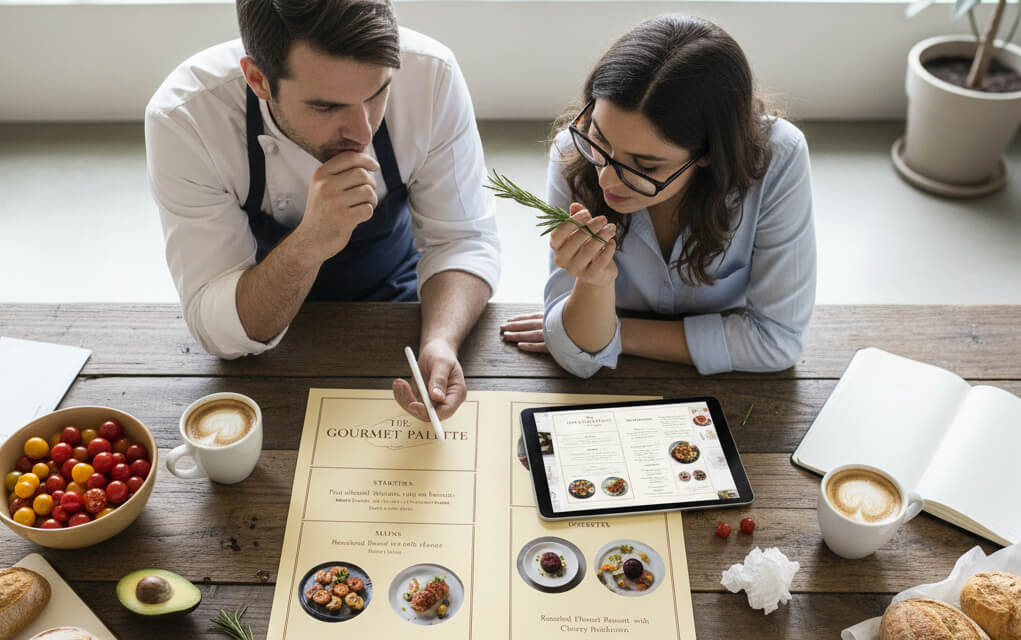October 07, 2025

A well-written menu is much more than a simple list of dishes—it’s a powerful marketing tool, a storytelling device, and a strategic way to elevate the overall dining experience. Every word used on a menu can influence a guest’s perception of value, stimulate cravings, and even affect what they ultimately decide to order. Restaurants that invest time and creativity into menu writing often see increased check averages, stronger brand identity, and greater customer loyalty.
Words have the power to trigger cravings. Using descriptive, sensory-rich language allows customers to taste the food before it even hits the table. When menu descriptions tap into sight, taste, smell, and texture, they create vivid mental imagery that entices diners on an emotional level.
This tactic doesn’t just help sell dishes—it enhances the guest’s anticipation and perceived value of the meal.
Bonus: Use sensory language on digital menus and third-party apps where guests don’t have visuals to rely on.
For more on enhancing your website content to attract diners, see Content Marketing for Restaurants: Blogs, Photos, & More.
Today’s diners are more ingredient-conscious than ever. They want to know where their food comes from, how it was sourced, and what makes it unique. By spotlighting locally-sourced, seasonal, or specialty ingredients, restaurants communicate quality, sustainability, and care.
This not only elevates the perceived value but also aligns with diners who prioritize farm-to-table, organic, or ethically-sourced options. It creates a sense of transparency and trust.
Pro tip: Use the origin of the dish itself to add depth: "This Moroccan lamb tagine is inspired by the spices of Marrakesh, slow-cooked with apricots and almonds."
Learn more about marketing plant-based and vegan options: Plant-Based Dining: How Restaurants Can Market Vegan Options.
While detail is important, overwhelming diners with overly long or technical descriptions can backfire. The ideal description balances brevity with impact—highlighting the most enticing aspects without requiring a deep read.
Remember, guests often scan menus quickly—especially on mobile or online ordering platforms. Make every word count.
Avoid common pitfalls with online content and menu presentation: The Most Common Restaurant Website Mistakes and How to Fix Them.
Modern diners expect menus to reflect a diverse range of dietary needs. Whether it’s food allergies, lifestyle choices, or ethical preferences, clear labeling empowers guests to make informed decisions and reduces the risk of mistakes.
Providing this information up front builds credibility and trust, and may increase the likelihood of customers recommending your restaurant to friends with specific dietary needs.
For insights on the impact of missing online information, see The Cost of Not Having a Website for Your Restaurant.
In a crowded market, storytelling sets your menu apart. Every dish has a backstory—whether it's inspired by a cherished family recipe, crafted around a seasonal ingredient, or influenced by the chef’s travels. Sharing this adds depth and authenticity to the dining experience.
"Inspired by the street markets of Bangkok, this Pad Thai blends rice noodles, tamarind sauce, and roasted peanuts for a sweet-savory kick."
Not only does storytelling create emotional resonance—it encourages diners to share the experience on social media or in reviews, extending your marketing organically.
External Reference: For tips on food writing and storytelling, check The Flavor Bible.
Menu writing isn’t a one-and-done effort. Just like your dishes, your descriptions should evolve based on customer feedback and performance data. Tracking which items sell well—and how wording affects those sales—can inform ongoing improvements.
Continual refinement can reveal small wording changes that lead to big revenue boosts. Even swapping one adjective or reordering a sentence can change how a dish is perceived.
External Reference: A study on menu psychology and ordering behavior can be found in the Journal of Consumer Research.
Crafting mouthwatering menu descriptions is a blend of marketing, psychology, and storytelling. Done well, a menu doesn’t just describe—it seduces. It doesn’t just inform—it connects. A great menu helps diners fall in love with a dish before they even taste it.
To recap:
Remember, your menu is more than just words—it's your brand's voice on the table. Whether in a fine-dining restaurant, a local café, or an online delivery platform, great menu writing can elevate every part of the dining journey.
Stay up to date with the latest tips, expert insights, product reviews, and step-by-step guides to help you grow, create, and succeed—no matter your industry or passion.